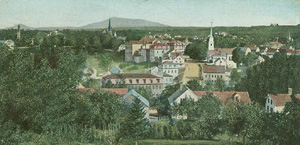Our History
 In 1735, the House of Representatives made the grant of "Ipswich Canada" or what is now Winchendon in answer to a petition from men who had participated in the expeditions against Canada in 1690 and in compensation for their sufferings and hardship but it was not until 1752 that the first settlers set up permanent residence in the Township. In the early days, a constant fear of Indians pervaded the community and several "block" houses were built. Gradually the Indians withdrew from this area never to again threaten "Ipswich Canada". Despite the fears the Indians brought, never a drop of blood was shed.
In 1735, the House of Representatives made the grant of "Ipswich Canada" or what is now Winchendon in answer to a petition from men who had participated in the expeditions against Canada in 1690 and in compensation for their sufferings and hardship but it was not until 1752 that the first settlers set up permanent residence in the Township. In the early days, a constant fear of Indians pervaded the community and several "block" houses were built. Gradually the Indians withdrew from this area never to again threaten "Ipswich Canada". Despite the fears the Indians brought, never a drop of blood was shed.In 1764, the residents petitioned the court to incorporate and asked for the name Epesberry. The petition came back with the name Winchendon, the name of the estate in England that Gov. Francis Bernard had a heir's interest in. After the incorporation in 1764, the people set the government of the town in operation. The number of inhabitants probably totaled two hundred, and the voice of the people ruled every detail of community life.
The early village centered around what is now referred to as Old Center for the first fifty years of the town's existence. Then the most significant move of all took place. More and more people saw the advantage of moving down the hill to the vicinity of Millers River (presently the foot of High Street) where there was an opportunity to utilize the water as a source of power. This vicinity was later to become the nucleus for the present-day Town of Winchendon. By 1800, there were about twenty two-story houses in Winchendon. The craftsmen of the era could fashion handsome buildings whose sturdiness and charm have survived the decades and given our town an historical richness.
Due to the abundance of water power, industry in Winchendon flourished with the working of wood into many forms and building the machines to work the wood. The first of these enterprises was the manufacture of shingles, which were made in such quantities in the late 1700's that neighboring people called this settlement "Shingletown." Next came wooden pails, tubs, clothespins, bobbins and a variety of other small wooden-ware products. These were expanded to include furniture and so many toys that later, at the turn of the 20th century, Winchendon became known as "Toy Town." Although known as a "wooden-ware town," the textile industry of the White's Mill became of equal importance to the prosperity of Winchendon.
During the later part of the 20th century, most of the manufacturing either moved south or out of the country; but the Yankee ethics for hard work and ingenuity still flourishes. The crown of the town's existence is her people, past and present. The individuals who dared to believe that it was practical and desirable to live and work in Winchendon.
























